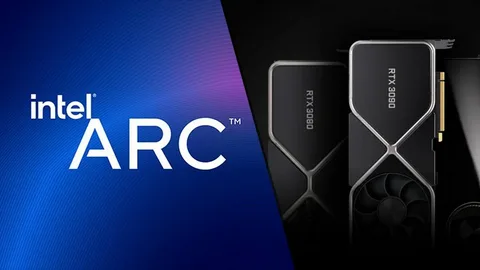You know how sometimes you walk into a party, and there’s that new person trying hard to fit in with the cool crowd? That’s pretty much the Intel Arc GPU in the gaming scene right now. A newcomer, full of ambition, but also learning the ropes on the fly. And honestly? Watching it grow is half the fun.
But let’s get serious for a minute, because if you’re thinking about dropping some hard-earned cash on an Intel Arc GPU, you deserve the unfiltered story. Spoiler: it’s complicated, but in a surprisingly charming way.
So, What’s the Deal With the Intel Arc GPU Anyway?
In case you’ve been living under a graphics-card-shaped rock, here’s the quick lowdown: Intel, the long-reigning CPU monarch, finally decided to crash the GPU party. The Intel Arc GPU series—like the A770 and A750—is aimed mostly at mainstream gamers. Think price-conscious, performance-hungry, and a little adventurous.
Intel’s pitch? Competitive pricing, solid hardware specs, and a truckload of promises about future updates. Oh, and a dash of that “underdog” energy we can’t help but root for. But does the Intel Arc GPU actually deliver when the rubber meets the digital road? Let’s fire up some games and find out.
Big League Games: How Arc Handles the Heavy Hitters
Right out of the gate, Intel had to prove it could keep up with the heavyweights. When it comes to AAA games—the Red Dead Redemptions, Cyberpunks, and Assassin’s Creeds of the world—the Intel Arc GPU holds its ground… mostly.
- Cyberpunk 2077: Running at 1080p High settings, the Arc A770 dishes out frame rates hovering around 60-70 FPS. It’s smooth enough for the casual dystopian explorer but falls behind RTX 3060 Ti by about 10-15%—not tragic, but noticeable.
- Forza Horizon 5: Here, the Intel Arc GPU flexes a little muscle. Thanks to Intel’s smart optimization for DirectX 12 games, you get near-parity with RX 6700 XT. Smooth, gorgeous, and honestly a joy to drive.
- Hogwarts Legacy: Mixed bag. Expect some frame pacing issues at launch, though patches (both Intel’s and the game’s) smoothed things out over time. Still, expect occasional magical hiccups.
The pattern’s pretty clear: DirectX 12 titles are Arc’s playground. Older APIs like DirectX 11? Well… let’s just say it’s a work in progress.
Quick Reflexes: Esports and Competitive Gaming
Alright, what about when you need every frame you can claw out—those sweaty-palms, fast-twitch multiplayer moments? Here’s the scoop:
- Valorant: No sweat. Easily pushes 200+ FPS at high settings. Intel Arc GPU absolutely crushes it here, matching RTX 3060 performance.
- CS:GO: Ehhh. Here’s where things get weird. Despite the low demands of CS:GO, the Intel Arc GPU sometimes struggles with consistent frame times. You’ll still hit 300+ FPS, but microstutters might make you miss that one crucial flick shot.
- Fortnite: Pretty impressive. Solid frame rates in DX12 mode; less so if you switch to DX11 or performance mode, where optimization isn’t as snappy.
Long story short? If you stick to newer engines or DirectX 12 settings, the Intel Arc GPU will make you a happy camper (or sniper, or spellcaster).
The Good, The Bad, and The Peculiar
Let’s just call a spade a spade: the Intel Arc GPU is a little quirky.
- Where It Shines:
→ DirectX 12 and Vulkan games
→ Ray tracing support is shockingly decent for a first-gen card
→ Pricing is aggressive and tempting, especially after a few driver updates ironed out early messes. - Where It Stumbles:
→ DirectX 9 games (old favorites like Skyrim or League of Legends) sometimes run worse than you’d expect.
→ Driver maturity is still catching up. Expect a few “wait, what just happened?” crashes now and then.
And you know what? That’s kinda part of the charm. The Intel Arc feels a little like buying a fixer-upper house—you know it’s gonna be awesome someday, but you’re gonna hit a few leaky pipes along the way.
How It Stacks Against the Usual Suspects
Naturally, comparisons are inevitable. When stacking the Intel Arc GPU against RTX 4060 or RX 7600, the conversation gets spicy.
- Against the green team? You lose on raw efficiency (Arc draws a bit more power), but you pay less and get surprisingly competitive ray tracing.
- Against the red team? Pretty even. RDNA 2 cards generally edge out Arc in older titles, but Arc holds its own in modern engines.
If you’re building a budget-to-mid-range PC, the Intel Arc throws a serious wrench into the old “just buy the others” advice. And honestly? That’s refreshing.
Should You Bet Your Framerate on an Intel Arc GPU?
Alright, the million-dollar question—should you actually buy one?
Here’s the thing: if you’re playing newer games, you love tinkering with settings, and you enjoy being part of something that’s still evolving, the Intel Arc GPU is a rock-solid choice. Plus, Intel’s commitment to monthly driver updates shows they’re serious about sticking around.
But if you need maximum stability across every single game from the last two decades. No exceptions. You might wanna stick to Team Green or Red for now.
Buying an Intel Arc GPU today is kinda like backing a promising indie band. Sure, there’ll be some rough concerts. But when it hits… oh boy, it really hits.
Wrapping It All Up
The Intel Arc GPU might not be perfect, but it’s perfectly interesting. In a gaming world that’s felt a little too much like a two-horse race, Arc feels like a breath of fresh, slightly chaotic air.
It’s fast where it counts, rough around the edges where you can (mostly) forgive it, and getting better month after month. If you’ve got a taste for adventure—and a backup game you can play while drivers update—the Intel Arc GPU might just be the dark horse your rig needs.
Honestly? I’m rooting for it.















